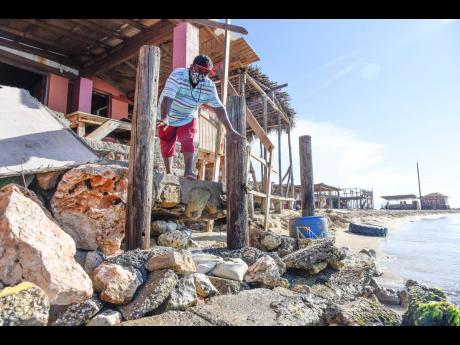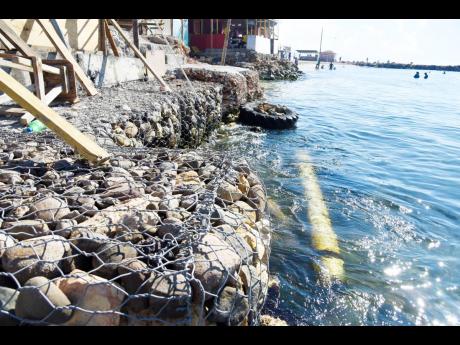‘How you can lose a beach in a lifetime’
Hellshire is poster child of shoreline erosion crisis
Pummeled by storm surges and compromised by other environmental hazards, there’s hardly a sliver of sand between some shops and the sea at Hellshire Beach in St Catherine.
Kingsley Johnson, operator of Any Money One Stop, has been doing business at the beach for a decade.
Reflecting on the earlier years, he said Sundays were the best business days.
Owing to beach erosion, he does not have enough space to accommodate as many customers as he did in the past.
“It nuh haffi be a storm fi cause problem, it can be bad weather. A two time me fix out here suh, and this is the third time I’m going to fix it,” he said, referring to the steps from the beach that lead up to the shop.
“Things have changed a lot. The horseman dem use to carry the horse from one end of the beach to the next. Now dem haffi ride it in the beach yard.”
Johnson said the main plea is to get the reef fixed.
Hellshire has also been badly affected by the worsening phenomenon of sargassum – seaweed that chokes the shoreline and whose pungent odour drives away some beachgoers when it starts to rot.
Sixty-year-old Hope Richards has experienced about four major storms on Hellshire Beach.
At 15, she began accompanying her grandmother to the beach where she played football, did horseback riding, and had a long stretch of sand to run across.
“We don’t have a beachfront anymore. Just a likkle piece right there and it tek time a wash weh,” she lamented.
Richards recently installed five gabion baskets at the front of her shop, but the high tide has sunk them.
“When the storm come, the water come through the shed. Sometimes it wash weh the big stones and we have to go for them at the seafront and throw them up back,” she explained.
Richards spends $20,000 for each basket and reasoned that if the reef is fixed, erosion could be greatly reduced.
“The future nuh look good like one time. Mash up! Wreck!” she told The Gleaner.
CORAL REEFS DYING
Deputy director of the Mona Geoinformatics Institute, Dr Ava Maxam, shared that about 20 beaches across Jamaica would take a longer time to rebound naturally should they undergo severe erosion.
“Hellshire is one of them, and it is a very famous case. Negril was also identified as being particularly prone. They are famous cases because they are associated with infrastructure, livelihoods that are significant, whether for tourism or people’s everyday living,” she said, adding that other beaches were identified in St Mary and Portland but are in underdeveloped areas.
For any foreseeable restoration of Hellshire Beach, Maxam said there must be a combination of hard and soft engineering.
Among the crisis concerns is that much of the coral reef has died and is crumbling, she said.
“There isn’t much live coral that would help to contribute sand and help the entire ecosystem thrive. Mangrove roots are very important for keeping the sediments together, and mangroves are also important for buffering a lot of the energy that comes from the sea in the form of really high waves,” Maxam told The Gleaner.
Hard engineering involves the construction of retaining walls and groynes.
Maxam added that Hellshire will require a combination of both as well as increased social awareness.
Annie Collash, 42, recalled how sad she felt as she watched how quickly the shoreline wore away over the last decade.
An employee at one of the food shops for 15 years, she has witnessed the damage meted out by strong currents to beachside businesses.
She said it began during the passage of Hurricane Ivan in 2004 and has been aggressive since.
“Normally, tourists and other people would come and spread out their towels and lie down on the sand. That can’t happen anymore because most of the sand is gone,” she said.
George Smart, a regular patron at Hellshire since the 1970s, shared that much has changed over the years. He said that nowadays, there is a steep fall of about two to three feet from the shoreline.
Meanwhile, Professor Mona Webber said beach erosion is an indication of damage to the coral reef.
The marine biologist said that the coral reef along the Hellshire coast has been under pressure from as early as the 1980s because of increased sewage input coupled with overfishing and human action.
“The marine life is under threat, the coral reef is threatened and it’s not healthy – not able to protect the beach as it should – and so the beach is eroding.
“The recent threat to marine life is more related to the sargassum build-up. Once the seaweed builds up and it starts to rot, it decreases the oxygen, and these marine creatures can’t get enough oxygen and they die,” Webber explained, adding that toxic gases are also released in the rotting process.
WHAT’S WEBBER’S FIX?
Acknowledging that it is not a popular view, Webber argues that people should not be living on the beach, nor should there be solid structures there.
“The sand is very dynamic. Sometimes you get sand build-up at one corner of the beach, and then it changes and moves to another corner, depending on the season,” she said in a Gleaner interview.
“When you interfere with the natural movement of sand, by putting in solid structures on the sand, you’re going to have erosion problems.”
Steps must be taken to curtail the discharge of sewage in the sea, she said.
“If it is not properly managed, Hellshire will be the perfect example of how you can lose a beach in a lifetime,” the marine biologist remarked.
In September, a beach erosion monitoring tower was installed at Hellshire under the Impact Assessment of Climate Change on the Sandy Shorelines of the Caribbean Project, which is an initiative of the Caribbean Sea Commission of the Association of Caribbean States.
It will be equipped with a video-monitoring system that will allow for 24-hour surveillance of beach processes.
Kenneth Benjamin, owner of the nearby Fort Clarence Beach, told The Gleaner that it has not suffered from erosion.
“We are in a lucky position where sand keeps building up. We have turbulent sand. There’s sand all over the place, but we have absolutely no erosion,” he said.
Benjamin said like Hellshire, sargassum is an issue that requires a three-member team to rake and remove the seaweed when the property is in operation.
The security mogul said that while successive administrations are acutely aware of the Hellshire crisis, budgetary constraints will continue to bump beach erosion off the agenda of national priorities.
Minister of Housing, Urban Renewal, Environment and Climate Change, Pearnel Charles Jr, who is representing Jamaica at the United Nations Climate Change Conference in Scotland, said several agencies are responsible for what is taking place at Hellshire.
“It’s part of the Government’s larger thrust towards climate action, and so we have specific work being done as it relates to the solutions around beach erosion, in terms of the activities that are taking place, minimising plastic waste, and the building up of infrastructure to protect our coastline,” Charles said.
He added that the national adaptation plan and the long-term low-carbon and climate resilience strategy are part of the framework to steer the country towards sustainable practices.






